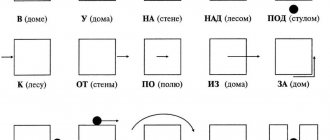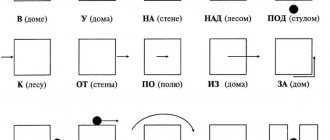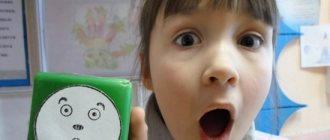Home - About speech therapy - Automation of sound pronunciation - when can you stop practicing?
Our life consists of daily communication. But it happens that a conversation with others causes awkwardness and embarrassment. Most often this happens if there are some defects in your speech (burr, lisp, etc.) that could not be corrected in childhood. Young children can be taken to see a speech therapist, but adults often do not seek help, thinking that it is too late. However, this is not at all true. Let's figure out how a speech therapist can help, what stages children and adults need to go through on the way to beautiful speech.
Speech therapist
is a specialist in the correction of oral and written speech.
At the first meeting, the specialist will conduct diagnostics, identify violations, their causes, and talk about plans to correct the defect.
What sound will the speech correction work begin with, and what sound will it end with? During the learning process, the planned route may change taking into account the characteristics and capabilities of your speech apparatus. It’s difficult to say about the exact timing: for some people the sound can be installed in one lesson, for others it takes a month or more.
Traditional work on correcting sound pronunciation consists of four stages:
1) Preparatory work (development of mobility of articulation organs, speech exhalation);
2) Direct sound production;
3) Automation of the delivered sound (fixing the sound in speech from simple to complex);
4) Differentiation of sounds (distinction by ear between sounds that are similar in articulation, mixed sounds. This stage will help to avoid mistakes in writing and dysgraphia in the future).
Let's talk about each stage in more detail.
Preparatory work.
Work on producing sounds begins with articulatory gymnastics. The tongue is a muscle. And this muscle needs to be developed and, most importantly, learned to control it. Certain articulation exercises activate specific areas of the tongue that are involved in the production of sounds. Such gymnastics is useful for children and adults even without speech impairments. It helps to speak more clearly, and elements of such gymnastics are used in public speaking classes. With complex speech disorders (for example, with dysarthia, which has become common lately), some parts of the tongue do not move and are tense, while in other cases they are very relaxed. These features are associated with a violation of muscle innervation; nerve impulses simply do not reach certain areas of the tongue and it becomes very difficult to control the tongue. Of course, this makes it difficult to speak sounds correctly.
At the same stage, work on breathing occurs. We also need it to produce many sounds. So, when pronouncing the sounds [S], [SH], the exhaled air flows through the middle of the tongue, with the sound [R], it “hits” its tip, and with the sound [L], it seems to “bend around” the tongue.
Automating sound in words
After several classes devoted to automating sounds in syllables, a new stage of work begins. The main task of the speech therapist at this stage of work is to teach the child to correctly pronounce words with the correct sound. Due to the fact that the newly developed neural connections are still weak, the child uses the acquired sound extremely irregularly, often only in classes with a speech therapist. If the kinesthetic analyzer is disrupted, he does not feel his pathological speech.
During the first lessons on automating sounds, the following principle should be observed: for the sounds [s], [w], words are selected in which these sounds appear at the beginning of the word ( s-s-s-son, s-s-s-cheese, s- s-s-russula, s-s-hell, s-s-sleigh, sh-sh-apka, sh-sh-fur coat
)
.
The sounds [ts], [h] are pronounced at the end of words in an emphatically short manner (
starling, palace, key, ball
)
.
The voiced sounds [b], [d], [g], [l] are first pronounced between vowels, then at the beginning of the word.
It is preferable to pronounce combinations of consonant sounds with vowel sounds that are close in articulation. For example, hissing - before [o] and [u] ( noise, fur coat, rustle
- lips protruded), soft whistling - before [i] (
Sima, winter, sieve
- lips stretched to the sides and brought together), [l] - in combination with [a] and [s] (
Alla, hello, lama, lamp, skis, skier
)
,
the sound [p] - after [t] and [d] (
grass, firewood, dragon, ladder, path, grass, friend
)
.
In subsequent lessons, these rules are not observed; it is permissible to use words in which the sound being studied occurs in different positions.
Working on the correct pronunciation of given sounds in words, and then in independent speech, is a difficult process that requires diligence from the child and patience from the speech therapist. Parallel work on the formation of phonemic processes with the simultaneous inclusion of tasks for the development of cognitive processes and lexical and grammatical exercises will help speed up the process of introducing sound into speech.
The work of automating sounds in words is to ensure that the child perceives the spoken word consciously in all its lexical and grammatical connections, and does not mechanically repeat it after the teacher. Such work is of little interest to the child and develops only the nominative function of speech. Therefore, it is necessary to give children as many tasks as possible aimed at developing other impaired functions. Work on automating sounds in words can be combined with enriching the vocabulary and mastering the grammatical categories of the language - word formation and inflection. The child should be introduced to the meaning and origin of spoken words. In the process of explaining the origin of words, the following questions would be appropriate: Why is this item called that? ( teapot, teapot, forget-me-not, Dunno
)
What
rainbow
mean ? At first, the speech therapist himself answers them, after listening to the child.
The skill of inflection is easily acquired by children in pure phrases - the most accessible and favorite form of exercise for them. Children repeat the syllables and complete the last word in pure speech. For example:
Wa-wa-wa,
sitting on a pine tree... (
owl
)
.
Woo-woo-woo
we saw... (
owl
)
.
You-you-you
sharp beak of ... (
owl
)
.
Ra-ra-ra,
glad for the snow...(
children
)
.
In addition to pure phrases, sentences are also used to help children learn the skill of inflection. Sentences are pronounced by a speech therapist, and the child completes them with individual words. The following tasks are offered: “Complete the sentence”, “What word is missing?”, “Give me the right word”, etc. Answering the questions: Who or what do you see? Who is the baby elephant standing next to? What is the table next to? Who does Zoya give the grass to? Who does mom care about? etc., the child practically learns the case endings of nouns. Here is an example of a task on automating the sounds [р], [р'] in words with a simultaneous exercise in mastering the skill of inflection.
- Who do you see? ( foal, camel, lamb, cow
etc.) Who is the baby camel standing next to?
(With a camel.
) Who did the calf run to?
( To the cow.
) Which domestic animal has horns?
( At the cow, at the ram.
)
The development of word formation skills is facilitated by the tasks “Say kindly”, “Let’s come up with a new word”. For example, when looking at a picture of a puddle, it is appropriate to ask the question: What do we call a large puddle? ( Puddles.
) And if it is a small puddle, we will say about it
...
(
puddle
)
.
In addition to nouns, other parts of speech, in particular adjectives, adverbs and verbs, should be included in classes as often as possible. For example, verbs are most suitable for automating the sound [l]. Answering the question: What did you do? ( Sang, danced, ate
etc.
_
d.), the child practices pronouncing words with the sound [l].
To automate the sound [l'], plural past tense verbs are used. To do this, the child is asked the question: What did we (you, they) (c) do? ( We sat, drew, danced.
)
Using verbs, you can practice the skill of forming new words using the prefixes po-, s-, pri-, pere-, u-
etc. To reinforce the sound [z], you can use verbs with the prefix
za-
(
drove in, came in, mended, pushed in,
etc.).
Incorporating riddles and poetry will add an emotional charge to the activity. The child names guess words and completes the words in familiar poems.
Considering that the system of speech therapy influence is complex, simultaneously with grammatical exercises, tasks are given for the development of cognitive processes (memory, attention and thinking): “What has changed?”, “What has disappeared?”, “Look, remember and say who where you stood”, “Listen and repeat the words”, “Do as it was”, “How many words did you remember?”, “How many objects did you remember?”, “Which object is extra?” and etc.
Thus, in one lesson, tasks are given that contribute to the development of not only speech, but also the child’s mental functions. And what is important, the implementation of several tasks is carried out with a minimum amount of visual material.
At this stage of work the following techniques can be used:
- pronunciation of the word by a speech therapist; showing pictures and naming objects by a speech therapist;
- joint pronunciation of a word with exaggerated emphasis on sound ( sssani, shshshuba
)
;
— clear repetition after the teacher of the word with an exaggerated pronunciation of the automated sound;
- independent pronunciation of a word from previously practiced syllables;
- sound analysis of the word; designation of sounds by accepted color symbols;
- composing a word from letters or reading;
- dividing a word into syllables;
- supplementing pure phrases with a given word;
- supplementing a sentence with a given word;
- reading a poem in which there are words with an automated sound; reproduction of individual words of the poem;
- making a riddle about an object (the child says the answer and individual words);
— work on the development of spatial, auditory, visual perception, memory and attention;
— work on lexical and grammatical categories of the language.
Particular attention at this stage of work is paid to the development of phonemic perception, phonemic analysis and synthesis, and phonemic representations.
Tasks and games that promote the formation of phonemic processes
Find pictures whose names contain the sound [r]. Choose pictures whose word names contain the sound [l] from a number of others.
Isolation of automated sound from words named by the teacher. Did you hear the sound [r] at the beginning, in the middle or at the end of the word?
Distinguishing between long and short words (using a sound ruler, tapping the sound and syllabic patterns of words).
Determining the position of sound in words after they are pronounced. Where is the sound [r] heard in the word rainbow
- at the beginning, in the middle or at the end of the word?
Where did you hear the sound [w] in the word cap
- at the beginning, in the middle or at the end of the word?
The same task is presented in different forms. The tasks may be different, but the goal is the same - for children to master the skill of sound and syllabic analysis of words.
Grandfather Sound Eater stole the sounds in words. ( Do... ozhka, ka...toshka.
)
Find the lost sound. ( Ka...a, ko...ka.
)
What sound is missing in the word? The word is pronounced ...aduga.
Say the whole word.
Name the missing sound. Pronounced: li...a.
Say the word in full.
Name the missing syllable. The word ma...na is pronounced.
Tasks are completed based on the picture.
Name the first sound. Name the last sound. Where is the sound [r] in the word arch
?Which is the sound [p] in the word
brand
?Between which sounds is the sound [p] in the word
watermelon
?
Arrange the pictures on the slats. On the top rail put pictures in the names of which the sound [s] is heard at the beginning of the word, on the bottom - with the sound [s] at the end of the word.
For sound analysis, words consisting of three sounds are first used. Along with words that have a fixed sound, words with purely pronounced sounds are also included. For example: noise, mouse, step, quiet, ear, ear, onion, varnish, juice, son, sleep, cheese, moss, poppy, nose, catfish, my, whale, current, so, may, echo, Kim, emu, they, com, snakes.
Name all the sounds in order. How many sounds are in a word? How many consonants are there? Name the vowel sound.
After children have mastered the sound analysis of words consisting of three sounds, they can begin to work on the sound analysis and synthesis of words consisting of four sounds, for example: cinema, horses, notes, cats, whales, Nina, mom, dad, sieve , sleigh, puma, fox, pony, Tina, Tim, duck, ducks.
Next, for sound analysis and synthesis, words of five sounds are taken, for example: thread, threads, skating rink, python, doll, sleigh.
Questions and tasks that develop phonemic and linguistic awareness can be as follows:
Name the vowel sounds of the word puddle.
Name the hard consonant sounds that are in this word.
Name the soft consonant sound that is in the word lemon.
Recognizing a word by the presence of consonant sounds: What word is intended if it contains the following consonant sounds: [r], [m], [w]? ( Chamomile
)
Recognizing a word by the presence of vowel sounds. Which vegetable's name contains the vowels [a], [u]? ( Watermelon.
)
“Scattering”, “scattering” of sounds. “Scatter” the sounds of the word cancer.
Throw the sound [r] to the right side, sound [a] to the left, and sound [k] straight ahead.
Composing a word from “scattered” sounds. Collect sounds into words. Collect the “scattered” sounds into a word. Collect a word from the sounds [s], [m], [k], [u], [a]. Composing a word from the first sounds of named words. For example, take the first sound from the words bag, autumn, moss.
Make a new word from these sounds.
Rhyming words. “Complete the word” (in a poem).
Puzzles. Crosswords.
Word in word. Finding a short word in a long word: coal
(
corner, goal, count
)
, seagull
(
tea, swing
)
, guillemot
(
clean
)
, hatchet
(
axe
)
, fight
(
crayfish
)
, cutlet
(
cat
)
, refrigerator
(
cold, cinema
)
, bedside table
(
barrel
)
, chimney
(
smoke , move
)
.
Transform words by changing or adding sounds (letters). For example:
Sound and letter s. WHO
-
nose;
juice -
rubbish
-
catfish;
hundred -
groan
-
haystack
-
drain
-
table
-
knock
-
chair;
wasp -
dew
-
braid
-
braids
-
dew.
Sound and letter z. Tooth
-
bison;
goat -
vine
-
vase;
carriage -
flowerpot;
umbrella -
umbrella;
bison -
can
-
loaf
-
bud.
Sound and letter l. Number
-
goal;
val -
hall;
bun -
squirrel;
cold -
hunger;
boat -
spoon.
Sound and letter sh. Mouse
-
mouse
-
bear;
Masha -
Dasha;
cat -
midge
-
fly
-
gun.
Sound and letter h. Bychok
-
tank
-
net;
daughter -
night
-
hummock
-
lobe
-
dot.
Sound and letter r. Mouth
-
ditch;
ladder -
trawl;
grotto -
thunder;
thunder -
grotto;
bean -
beaver;
cat -
mole;
mouth -
grotto;
path -
path;
gate -
crow
-
crown
-
cow;
fish -
fisherman
-
fish
-
fishermen
-
little fish.
Inverted words.
Pine
-
pump, lump
-
wet, current
-
cat, rubbish
-
grew, nose
-
sleep.
Sound production.
When the preparatory work has been completed, the speech therapist begins sound production. That is, it tries to evoke the correct sound. There are different options for how to do this: by imitation, when a person repeats after a speech therapist, mechanically with the help of special speech therapy probes, from reference sounds, etc. How quickly the sound rises depends on the readiness of the articulatory apparatus: on the person’s ability to control his tongue and lips. The skill of speech exhalation is important. Sometimes the sound is staged in one lesson, in other cases it takes more time and the use of different production methods.
Difficulties in production [c]
Problems during sound production can be completely different, the main ones include the following:
- Weak innervation of the muscles of the speech apparatus. This is expressed in the fact that due to insufficient muscle tone of the organs of articulation (in particular the vocal cords, since they play the main role in the pronunciation of a given sound), the child simply cannot pronounce the sound. Without the participation of the voice, it turns out [f] instead of [v]. It will take time to develop connections so that the pronunciation is clear and correct.
- Malocclusion. This fact can also influence and give its complications in the staging [c], but this does not always happen.
- Lip defect. When pronouncing “B”, not only the teeth are involved, but also the lips. A short or drooping lower lip can make sound production difficult.







